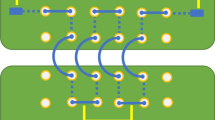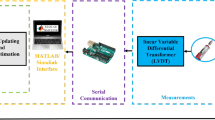Abstract
In this research, we present a dynamic high gain observer (HGO) combined with a sliding mode controller (SMC) for a novel shape memory alloy (SMA) actuator. The dynamic model of the SMA actuator contains nonlinearities with hysteresis, which makes the estimation of velocity and acceleration of the actuator challenging. We first design a dynamic HGO to estimate velocity and acceleration of the SMA actuator by considering nonlinearities with hysteresis in the dynamics. We then develop a SMC for the actuator using the estimated velocity and acceleration. The proposed SMC in conjunction with the dynamic HGO is tested experimentally for the actuator. For comparison, trajectory tracking experiments are also conducted by using PID without an observer, SMC without an observer, and SMC with a non-dynamic HGO. Our results confirm that the dynamic HGO combined with SMC can enhance trajectory tracking accuracy while reducing the chattering phenomenon.








Similar content being viewed by others
Data availability
The authors declare that experimental and simulation data are available within the paper. Raw data will be available from the corresponding author upon reasonable request.
References
Ahrens JH, Khalil HK (2008) High-gain observers in the presence of measurement noise: a switched-gain approach. IFAC Proc 41(2):7606–7611
Brinson LC (1993) One-dimensional constitutive behavior of shape memory alloys: thermomechanical derivation with non-constant material functions and redefined martensite internal variable. J Intell Mater Syst Struct 4(2):229–242
Cecilia A, Serra M, Costa-Castelló R (2021) Nonlinear adaptive observation of the liquid water saturation in polymer electrolyte membrane fuel cells. J Power Sources 492:229641
J. H. Crews, R. C. Smith, and J. C. Hannen, Development of robust control algorithms for shape memory alloy bending actuators. pp. 391–400.
Dinh TN, Park J, Park K-S (2020) Design and evaluation of disturbance observer algorithm for cable-driven parallel robots. Microsyst Technol 26(11):3377–3387
Ghanmi B (2022) Luenberger observer of impulsive systems: a survey. In: Naifar O, BenMakhlouf A (eds) Advances in observer design and observation for nonlinear systems fundamentals and applications. Springer International Publishing, Cham, pp 71–85
Giap V, Vu H, Nguyen Q, Huang S-C (2022) Chattering-free sliding mode control-based disturbance observer for MEMS gyroscope system. Microsyst Technol 28(8):1867–1877
Gurung H, Banerjee A (2016) Self-sensing Shape Memory Alloy wire actuator based on Unscented Kalman Filter. Sensors Actuat A Phys 251:258–265
Jafari M, Mobayen S, Roth H, Bayat F (2022) Nonsingular terminal sliding mode control for micro-electro-mechanical gyroscope based on disturbance observer: linear matrix inequality approach. J Vib Control 28(9–10):1126–1134
Jayaramu ML, Suresh HN, Bhaskar MS, Almakhles D, Padmanaban S, Subramaniam U (2021) Real-time implementation of extended kalman filter observer with improved speed estimation for sensorless control. IEEE Access 9:50452–50465
Khan AM, Kim Y, Shin B, Moghadam MH, Mansour NA (2022a) Modeling and control analysis of an arc-shaped SMA actuator using PID, sliding and integral sliding mode controllers. Sensors Actuat A Physical 340:113523
Khan AM, Shin B, Usman M, Kim Y (2022b) Backstepping control of novel arc-shaped SMA actuator. Microsyst Technol 28(10):2191–2202
Łakomy K, Madonski R (2021) Cascade extended state observer for active disturbance rejection control applications under measurement noise. ISA Trans 109:1–10
Lara-Ortiz V, Guarneros A, Llorente-Vidrio D, Cruz-Ortiz D, Salgado I, Chairez I (2022) Active disturbance rejection controller for a flexible walking bioinspired inchworm mobile robot actuated with shape memory alloy devices. IEEE Trans Control Syst Technol 30(4):1790–1797
Lee HS, Ryu S (2021) Design of a robust controller for a rotary motion control system: disturbance compensation approach. Microsyst Technol 27(6):2293–2302
Li X, Zhang B, Zhang D, Zhao X, Han J (2021) Disturbance compensation-based output feedback adaptive control for shape memory alloy actuator system. Int J Adv Robotic Syst 18(1):1729881421993998
Liang C, Rogers CA (1990) One-dimensional thermomechanical constitutive relations for shape memory materials. J Intell Mater Syst Struct 1(2):207–234
Mohammad HE, Mehdi A, Hashem A (2004) Design of a Kalman filter for rotary shape memory alloy actuators. Smart Mater Struct 13(4):691
Park S, Oh K, Jeong Y, Yi K (2020) Model predictive control-based fault detection and reconstruction algorithm for longitudinal control of autonomous driving vehicle using multi-sliding mode observer. Microsyst Technol 26(1):239–264
Rauh A, Romig S (2021) Linear matrix inequalities for an iterative solution of robust output feedback control of systems with bounded and stochastic uncertainty. Sensors 21(9):3285
Acknowledgements
This research was mainly supported by the National Research Foundation of Korea (NRF) grant funded by the Korea government (MSIT) (No. 2022R1A2C1011462). This research was also partially supported by “Regional Innovation Strategy (RIS)” through the National Research Foundation of Korea (NRF) funded by the Ministry of Education (MOE) (2021RIS- 004) and by the research fund of Hanbat National University in 2023. The first author is funded by the Korea Research Fellowship (KRF) program by the National Research Foundation (NRF) with KRF Grant (2019H1D3A1A01102998).
Funding
National Research Foundation of Korea (NRF), 2019H1D3A1A01102998,Abdul Manan Khan, 2022R1A2C1011462,Youngshik Kim, 2021RIS- 004, Youngshik Kim
Author information
Authors and Affiliations
Corresponding author
Additional information
Publisher's Note
Springer Nature remains neutral with regard to jurisdictional claims in published maps and institutional affiliations.
Appendices
Appendix A
Convergence of the dynamic high gain observer-based sliding mode controller
We choose the following Lyapunov function v and differentiate it to design the SMC,
Where s is the sliding surface (9). Using (2) and (10)
If we choose the control law (10),
then, we can write eq. (15) by using boundary conditions (11) and (12) as,
Applying the upper bound of ∆ with D, we have,
Simplifying above equation, we get,
where \(f- \widehat{f}=\widetilde{f} \left(x\right)\) represents model uncertainties and is bounded by \(\left|\widetilde{f} \right|\le F\). Considering eq. (15), it can be shown that
Thus, if we choose \({K}_{{s}_{1}}\) and \({K}_{{s}_{2}}\) large to satisfy following condition,
Then, we have,
which shows that SMA system with proposed controller would always dissipate energy and the system will become stable by the Lyapunov stability theorem. Once, \(\dot{V}<0\) is ensured, \(s\) converges to zero. Thus, on the sliding surface where \(s=0\), we have,
which infers that
We can express (24) as follows,
Now we can choose \({c}_{{s}_{1}}\) and \({{c}_{s}}_{2}\) to place poles to achieve our desired performance. Gains, \({K}_{{s}_{1}}\) and \({K}_{{s}_{2}}\), are used to attract the system states to the sliding surface (ensured by Lyapunov convergence). Parameters, \({c}_{{s}_{1}}\) and \({c}_{{s}_{2}}\), ensure convergence of the state errors to zero along the sliding surface.
Rights and permissions
Springer Nature or its licensor (e.g. a society or other partner) holds exclusive rights to this article under a publishing agreement with the author(s) or other rightsholder(s); author self-archiving of the accepted manuscript version of this article is solely governed by the terms of such publishing agreement and applicable law.
About this article
Cite this article
Khan, A.M., Bijalwan, V., Baek, H. et al. Dynamic high-gain observer approach with sliding mode control for an arc-shaped shape memory alloy compliant actuator. Microsyst Technol (2024). https://doi.org/10.1007/s00542-024-05646-7
Received:
Accepted:
Published:
DOI: https://doi.org/10.1007/s00542-024-05646-7




